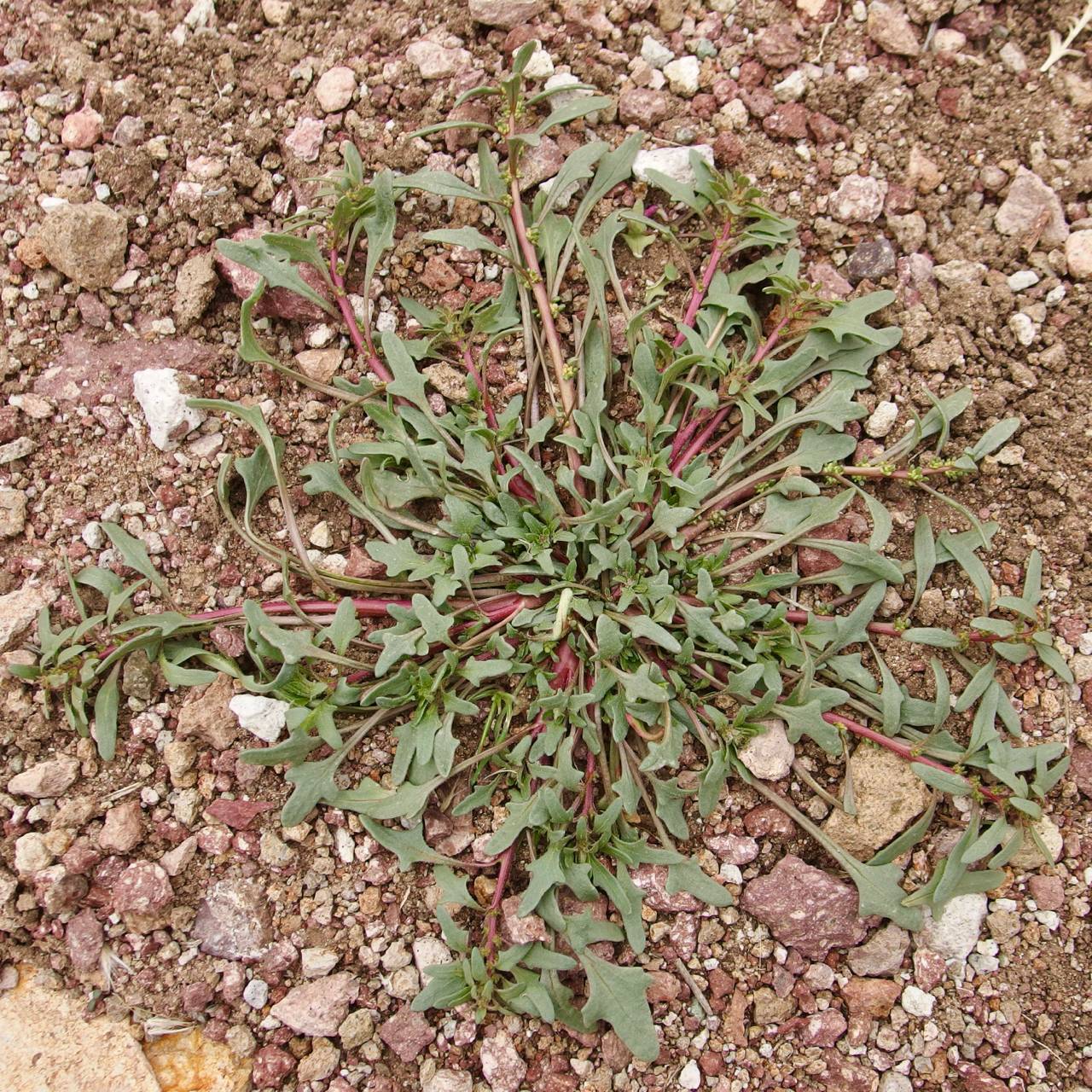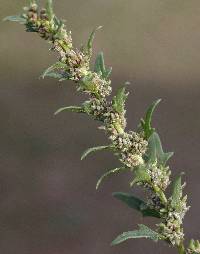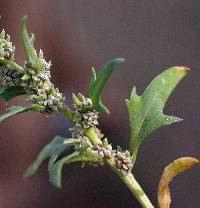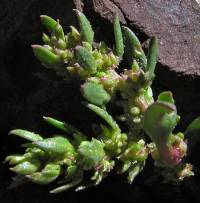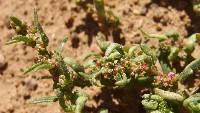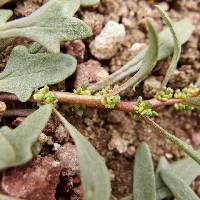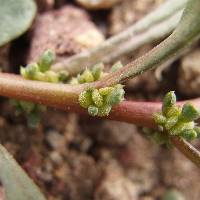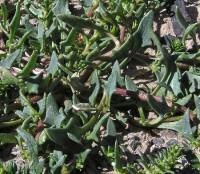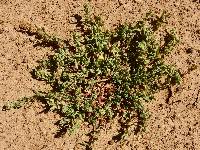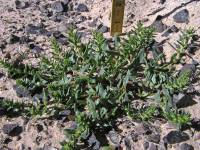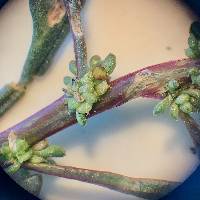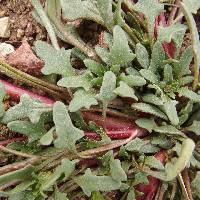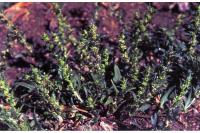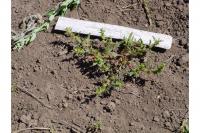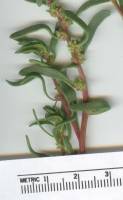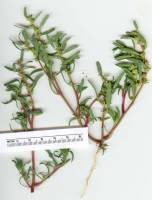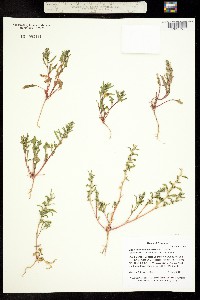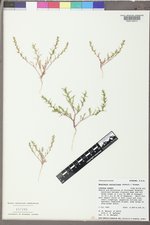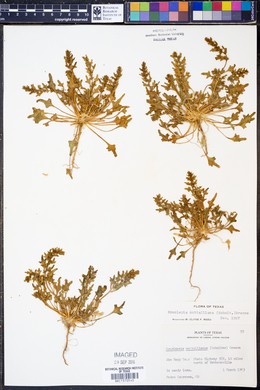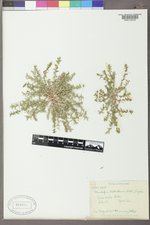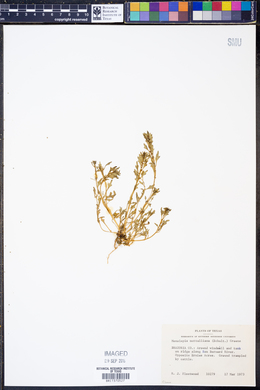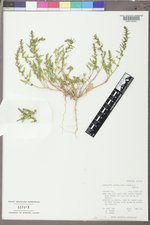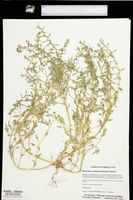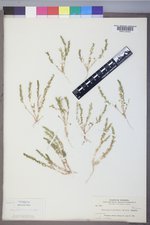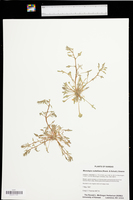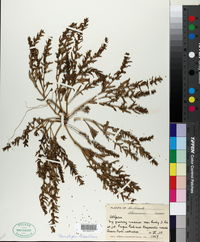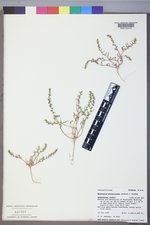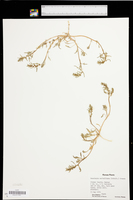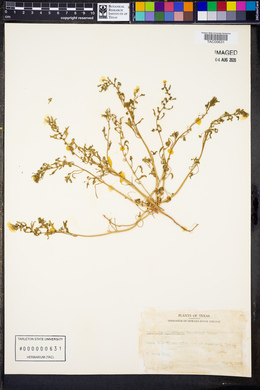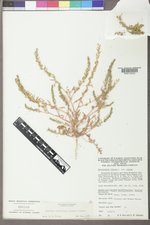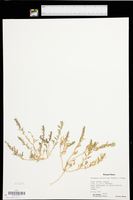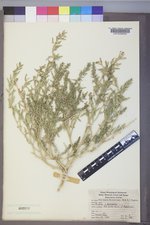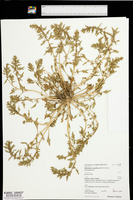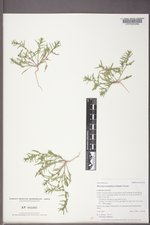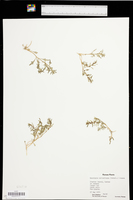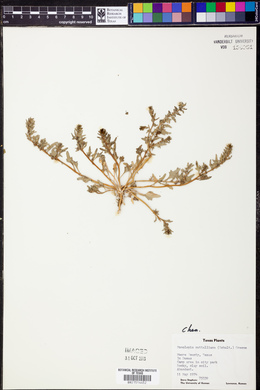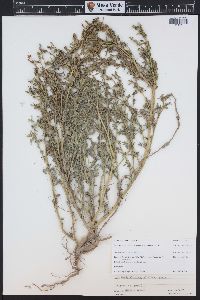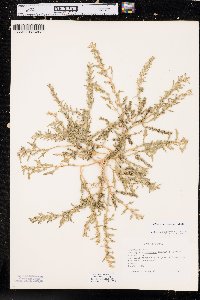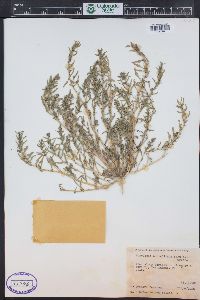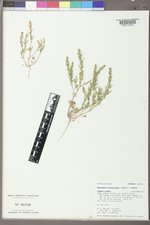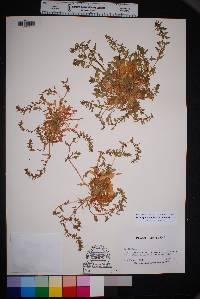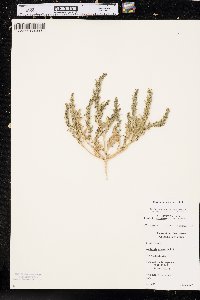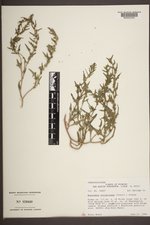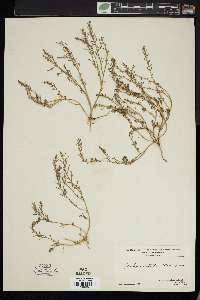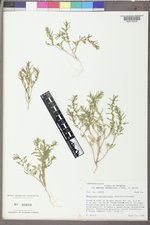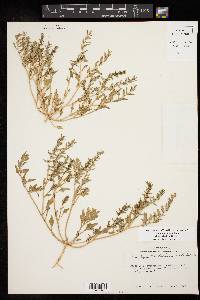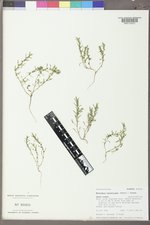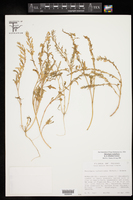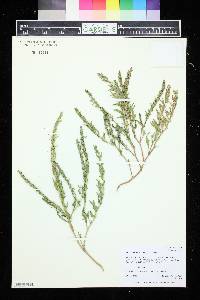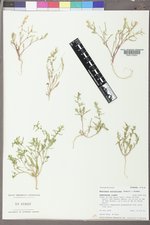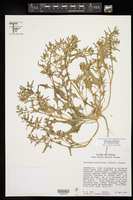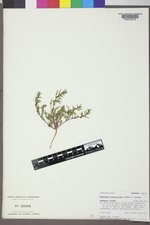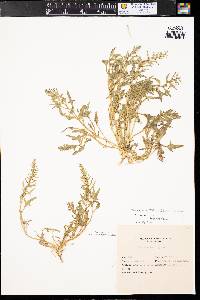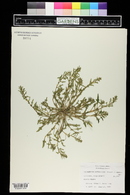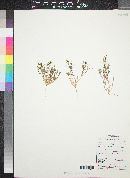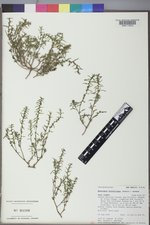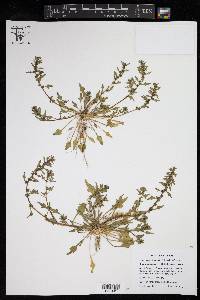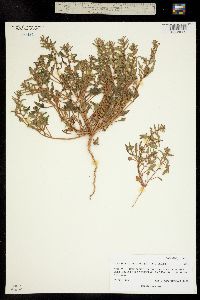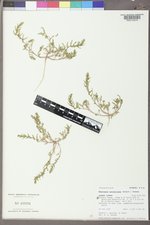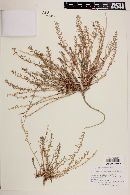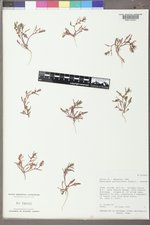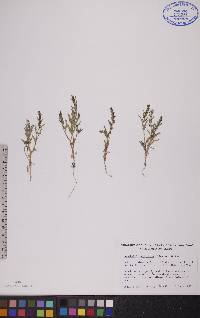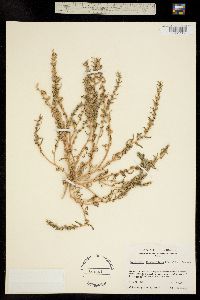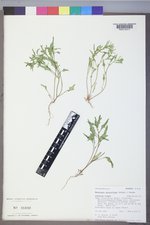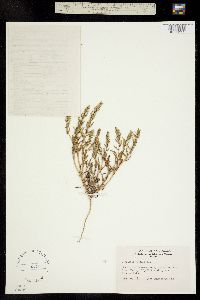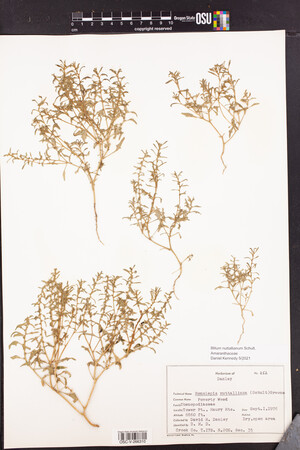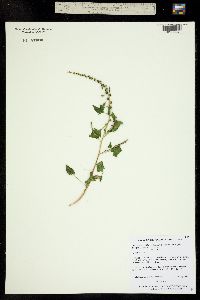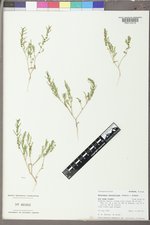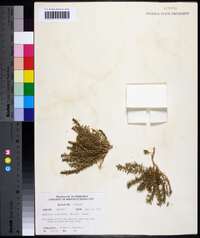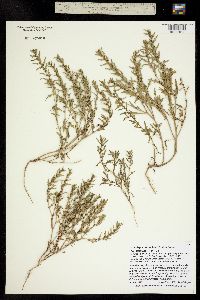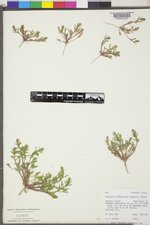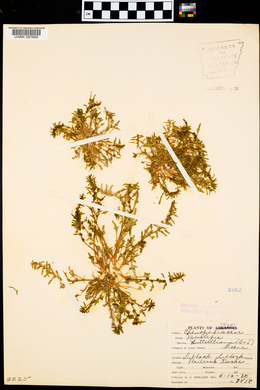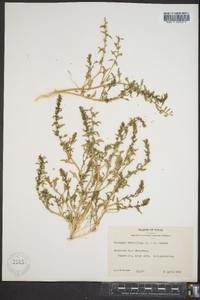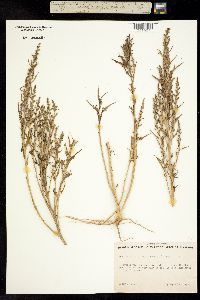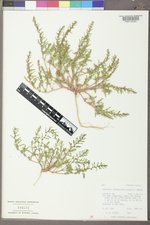
|
|
|
|
Family: Amaranthaceae
Nuttall's Poverty-Weed, more...Nuttall's Poverty-Weed (es: patata)
[Monolepis chenopodioides Moq., moreMonolepis nuttalliana (Schult.) Greene] |
Stems prostrate to ascending, 0.5-2(-5) dm, herbage sparsely farinose when young, becoming glabrate. Leaves: petiole 0.1-3(-6) cm, longest on proximal leaves, distal leaves sometimes sessile; blade of principal leaves hastately lobed near base, narrowly triangular, lanceolate, narrowly elliptic, or linear, 1-3(-4) cm × 2-15(-25) mm at lobes, base narrowly attenuate or cuneate, margins sometimes with few teeth distally, apex obtuse to rounded; distal leaves sometimes completely unlobed. Flowers: perianth segment 1, spatulate or obtuse, 1 mm; stamen 1. Utricles 1.1-1.5 mm; pericarp readily separating from seeds, whitish, membranous, cellular-reticulate. Seeds dark brown to black, laterally flattened, broadly ovoid. 2n = 18. Flowering early spring-mid summer, fruiting through Aug. Usually moist, subalkaline clays, often in partial shade or open disturbed habitats; 100-3000 m; Alta., B.C., Man., N.W.T., Sask., Yukon; Alaska, Ariz., Calif., Colo., Idaho, Kans., Minn., Mont., Nebr., Nev., N.Mex., N.Dak., Okla., Oreg., S.Dak., Tex., Utah, Wash., Wyo.; n Mexico. Annual herb 10 cm - 0.5 m tall Stem: prostrate to ascending, much-branched, sparsely white-mealy when young, becoming smooth with age, slightly succulent. Leaves: alternate, stalked, sometimes stalkless (upper leaves), 1 - 3 cm long, 2 mm - 1.5 cm wide (with lobes), unlobed or two-lobed (arrowhead-like), narrowly triangular to egg-shaped to lance-shaped with a tapering base and blunt to rounded tip, sometimes few-toothed. Inflorescence: a terminal, leafy spike of flowers. Flowers: stalkless, greenish, small, with one bract-like sepal and no petals. Stamen one. Stigmas two. Fruit: one-seeded (utricle), 1 - 1.5 mm wide, somewhat flattened. Wall (pericarp) loose and easily separable from the seed, whitish, membranous. Seed vertical, black or dark brown, broadly egg-shaped, flattened. Similar species: No information at this time. Flowering: late May to early June Habitat and ecology: Introduced from west of the Chicago Region. Found in alkaline, often arid, areas west of the Chicago Region, but has begun to appear locally in fairgrounds. Occurence in the Chicago region: non-native Etymology: Monolepis comes from the Greek words monos, meaning solitary, and lepis, meaning scale, in reference to the single sepal. Nuttalliana is named after Thomas Nuttall (1786-1859), the English botanist who first described this plant. Author: The Morton Arboretum Wiggins 1964, Kearney and Peebles 1969, Felger 2000, Heil et al 2015 Duration: Annual Nativity: Native Lifeform: Forb/Herb General: Semisucculent annual herb, stems decumbent to ascending, 10-35 cm long, unbranched or branching close to the base; herbage moderately scurfy-farinose in youth, soon glabrate. Leaves: Alternate, succulent, triangular to lanceolate-hastate, 3-12 mm wide, 1-7 cm long; lower leaves hastately lobed and on slender petioles to 6 cm long; upper leaves sessile, often entire and reduced to leafy bracts. Flowers: Inconspicuous, greenish and sometime suffused with pink, in dense sessile axillary clusters; each flower with a single perianth segment, 1 mm long, spatulate to obtuse and partially spreading at maturity. Fruits: Lentil-shaped, minutely pitted utricle, 1 mm in diameter and 0.5 mm thick, with a grayish membranous pericarp. Ecology: Found on dry or alkaline and often heavy soil below 10,000 ft (3048 m); flowers February-October. Distribution: Most of N. Amer. except for southeastern states; also in S. Amer. Notes: Distinguished by being mostly found in alkaline areas; the spreading growth form with succulent, triangular to spatulate leaves, and small dense axillary clusters of small flowers. Superficially resembles other succulent, prostrate weeds such as Portulaca oleracea and Trianthema portulacastrum, but those have roundish leaves; Portulaca halimoides and Halogeton glomeratus are also succulent and spreading but have cylindric, un-lobed leaves, and Halogeton-s leaves are also spine-tipped; and species in the genus Chenopodium have similar flower types and often have similar hastately lobed leaves, (both Monolepis and Chenopodium were traditionally treated in the Chenopodiaceae) but Chenopodium species tend to be larger and upright, not prostrate. Ethnobotany: Used as a ceremonial emetic, as a poultice for skin abrasions, and eaten; seeds were ground to make mush and pinole, the roots were boiled, and the greens were eaten. Etymology: Monolepis is from the Greek monos, one and lepis scale, referring to the single perianth segment in each flower; nuttalliana honors Thomas Nuttall (1786-1859) an English botanist. Synonyms: Blitum nuttallianum Editor: SBuckley 2010, FSCoburn 2015, AHazelton 2015 Winter annual; stems slightly succulent, much branched, spreading or ascending, 1-5 dm; lvs lanceolate to ovate, to 5 cm (petiole included), entire or variously toothed, commonly with a single large salient tooth on each side near the middle, cuneate to the base; fls numerous, much shorter than the lvs; sep green, spatulate or obovate, 1-2 mm. Dry, often alkaline soil; Man. to w. Mo., Tex., and n. Mex., w. to the Pacific, and occasionally adventive eastward. Gleason, Henry A. & Cronquist, Arthur J. 1991. Manual of vascular plants of northeastern United States and adjacent Canada. lxxv + 910 pp. ©The New York Botanical Garden. All rights reserved. Used by permission. From Flora of Indiana (1940) by Charles C. Deam ...... Indiana Coefficient of Conservatism: C = null, non-native Wetland Indicator Status: UPL Diagnostic Traits: annual; principal leaves hastate; flowers in axillary clusters; sepals 1; fruits ovoid, compressed, wingless. |
|
|
|

